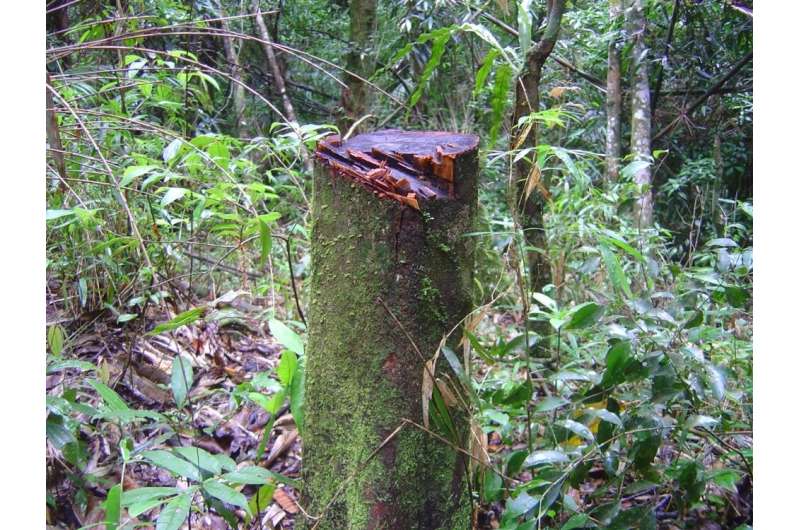Study quantifies impact of human activity on Atlantic Rainforest's carbon storage capacity

The countless benefits of native forests include the capacity of tree biomass to store large amounts of carbon, which can counterbalance greenhouse gas emissions into the atmosphere. A paper published in the journal Science Advances reports on an innovative analysis of a large dataset designed to clarify the concept of carbon sequestration, a strategic issue in the discussion of global climate change.
"We still know little about the factors that can lead forests to store more or less carbon," said Renato Augusto Ferreira de Lima, one of the paper's ten authors. Lima is affiliated with the Ecology Department at the University of São Paulo's Institute of Biosciences (IB-USP) in Brazil and is currently a researcher at the Center for Biodiversity Synthesis and Analysis (CESAB) in Montpellier (France).
"We used a large forest inventory database to see which factors are uppermost in explaining current levels of carbon storage in the Atlantic Rainforest. We found that factors relating to the different types of human impact on the forest are key, with two to six times the significance of factors such as climate, soil and the characteristics of the tree species in the forest," he said.
Reversing the effects of human activity on Atlantic Rainforest remnants would therefore be the best strategy to increase forest carbon stocks. About 50% of the Brazilian population currently live in areas originally occupied by the biome.
According to Marcela Venelli Pyles, first author of the paper and a Ph.D. candidate in applied ecology affiliated with the Ecology and Conservation Department of the Federal University of Lavras (UFLA) in Minas Gerais, Brazil, conservation of carbon stocks in the Atlantic Rainforest is highly dependent on forest degradation, which can lead to carbon losses that are at least 30% worse than any future climate change. Moreover, emissions from forest degradation can hinder conservation efforts pledged in climate change mitigation agreements, such as REDD+ and the Aichi targets.
REDD stands for "Reducing Emissions from Deforestation and Forest Degradation." The plus sign in REDD+ refers to "the role of conservation, sustainable management of forests and enhancement of forest carbon stocks in developing countries," according to the UN Framework Convention on Climate Change, which adopted this mechanism to reward developing countries financially for climate change mitigation.
The Aichi Biodiversity Targets were 20 global targets for biodiversity loss reduction to be met by 2020, agreed at the Tenth Conference of the Parties to the UN Convention on Biological Diversity (CBD), held in Nagoya, Aichi Prefecture, Japan, in 2010.
Tree damage and mortality due to disturbances in Atlantic Rainforest fragments resulting from canopy opening and microclimate changes can lead to carbon losses of up to 10.50 metric tons per hectare, corresponding to emission of 15.24% of the carbon stored in 1 hectare, while carbon storage protection and enhancement can achieve gains of 12.02 tons per hectare, increasing storage by 17.44%.
Warmer climate
Besides degradation due to human activity, the study also analyzed how climate change, particularly rising temperatures and water stress, endangers carbon storage by the Atlantic Rainforest. If global warming is limited to 1.5 °C above pre-industrial levels, as suggested by the Intergovernmental Panel on Climate Change (IPCC), the Atlantic Rainforest alone will release 3.53 tons per hectare (+ 5.12%). "But if the average temperature continues to rise at the current rate, carbon emissions could exceed 9.03 tons per hectare (+ 13.11%)," Pyles said.
The paper also argues that climate change mitigation actions involving forest restoration could benefit from the inclusion of species with higher wood density, heavier seeds and larger leaves, and that carbon conservation policy should take into account methodologies used to quantify carbon stocks. "The difference between methodologies used in the field can lead to errors in estimating carbon, entailing misinterpretation and inefficient climate change mitigation measures," Pyles said.
The paper also notes a "weak relationship" between taxonomic and functional diversity and carbon storage in the Atlantic Rainforest. From this, it infers that conservation policies focusing only on carbon may fail to protect biodiversity and that separate incentive mechanisms to conserve species should be considered.
According to Lima, the findings on the Atlantic Rainforest offer potential lessons for other forests around the world in terms of nature-based solutions to combat the adverse effects of climate change and human activity.
The paper is also signed by Luiz Fernando Silva Magnago (Federal University of Southern Bahia), Bruno X. Pinho (Federal University of Pernambuco), Gregory Pitta (USP), André L. De Gasper and Alexander C. Vibrans (Regional University of Blumenau), and Vinícius Andrade Maia, Rubens Manoel dos Santos and Eduardo van den Berg (UFLA).
More information: Marcela Venelli Pyles et al, Human impacts as the main driver of tropical forest carbon, Science Advances (2022). DOI: 10.1126/sciadv.abl7968
Journal information: Science Advances
Provided by FAPESP





















